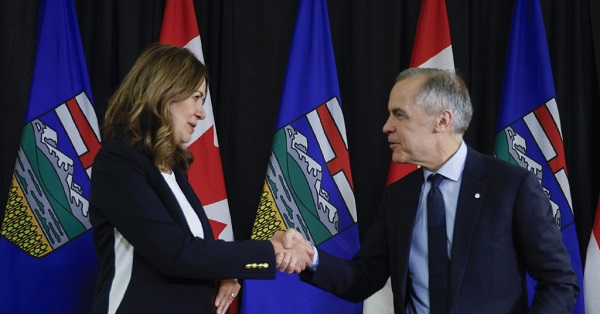Alberta
Project Confederation group urging UCP Leadership hopefuls to consider Alberta first

Article submitted by Josh Andrus of Project Confederation
The current Alberta government has certainly talked the talk about standing up to the federal government much better than previous administrations.
Actions speak louder than words, though, and action has been sorely lacking.
It has been more than nine months since Albertans strongly voiced their opinion in favour of abolishing equalization from the Constitution.
In the aftermath, the muted response from the federal government speaks volumes – when we called, nobody answered.
It has, therefore, become glaringly obvious that the equalization referendum was not enough to convince Ottawa to come to the table and initiate constitutional talks.
It’s also important to make sure we keep focused not just on any one particular problem, but on the core issue itself – the jurisdictional fight between the federal government and the provinces.
That’s why we need to effectively communicate to every Albertan three things:
- How the Canadian federation is supposed to work
- How it’s actually being run at the moment
- How to fix the problem and get it back to how it should be
1 How Canada is supposed to work is misunderstood (or misrepresented, perhaps deliberately so) all the time by the media, academics, politicians, and many others.
Canada is designed as a federation, and that word actually means something.
A federation is a union of (at least partially) self-governing states or provinces.
The creation of Canada didn’t merge a bunch of provinces, territories, colonies and countries into a single new entity.
Canadian confederation created a system where there was a clear division of powers between the federal government and the provinces.
Many (especially in Ottawa) think that the federal government sits “above” the provinces, suggesting it is more important, more powerful, and can tell the “lower” level of government what to do.
In fact, the federal government has complete sovereignty over the issues they were given jurisdiction over, while the provincial governments have complete sovereignty over the issues they were given jurisdiction over.
In short, Alberta – and all the other provinces – are supposed to be equal partners in this country, not subservient to continuously hostile federal governments in Ottawa.
2 Unfortunately, over time, the federal government has exerted jurisdiction over things it’s not supposed to control, and because the federal government gets to appoint federal judges, the federal judges have tended, also over time, to let the federal government get away with this.
Historically, this has involved ever-increasing federal control of natural resources and environmental concerns and the current federal government continued this trend, spending the past seven years trampling all over the constitutional jurisdiction of Alberta – through Bill C-69, Bill C-48, the carbon tax, and more.
Worse, they haven’t just completely ignored Alberta’s complaints about this overreach – they’ve actually continued to make things worse.
Since the equalization referendum, the federal government has continued to roll out even more new federal policies that will take over Alberta’s jurisdiction on a wide range of issues – childcare funding, healthcare rules, agriculture and fertilizer constraints, environment regulations, and more.
The current relationship between federal and provincial governments in Canada is not how it is supposed to be, and it isn’t sustainable.
Something has to give.
3 Given this approach by the federal government, it has become abundantly obvious that the equalization referendum was not enough to convince Ottawa to come to the table and negotiate some kind of compromise with Alberta.
Alberta must stand up for itself.
Alberta needs to start saying no to Ottawa, not just asking Ottawa nicely to change their mind.
Alberta must also demand that the Canadian Constitution be re-opened.
If the federal government’s judges are willing to twist the words in the Constitution so much that they become meaningless, then we need to re-write sections of the Constitution to make it crystal clear, in plain language, that the federal government’s current actions will not be tolerated or permitted any longer.
At a minimum, these changes would involve:
- Abolishing equalization
- A fair House of Commons
- An equal Senate
- Unrestricted free trade (including pipelines)
- Complete provincial control over resources
Yes, this would be a big change from the current status quo.
But, let’s be clear, that’s only because things have drifted so far from what they are supposed to be.
Albertans are not actually asking for anything unique or radical.
We are simply asking for the federal government to follow the rules of the Constitution as they are written, not as they’ve been twisted to mean since.
And if the federal government won’t even agree to something as simple as that, well… at least we’ll have our answer then
Regards,
Josh Andrus
Executive Director
Project Confederation
PS: If you’re in a position to contribute financially to our important work fighting for Alberta, you can make a donation here.
Alberta
Alberta Next Panel calls to reform how Canada works

From the Fraser Institute
By Tegan Hill
The Alberta Next Panel, tasked with advising the Smith government on how the province can better protect its interests and defend its economy, has officially released its report. Two of its key recommendations—to hold a referendum on Alberta leaving the Canada Pension Plan, and to create a commission to review programs like equalization—could lead to meaningful changes to Canada’s system of fiscal federalism (i.e. the financial relationship between Ottawa and the provinces).
The panel stemmed from a growing sense of unfairness in Alberta. From 2007 to 2022, Albertans’ net contribution to federal finances (total federal taxes paid by Albertans minus federal money spent or transferred to Albertans) was $244.6 billion—more than five times the net contribution from British Columbians or Ontarians (the only other two net contributors). This money from Albertans helps keep taxes lower and fund government services in other provinces. Yet Ottawa continues to impose federal regulations, which disproportionately and negatively impact Alberta’s energy industry.
Albertans were growing tired of this unbalanced relationship. According to a poll by the Angus Reid Institute, nearly half of Albertans believe they get a “raw deal”—that is, they give more than they get—being part of Canada. The Alberta Next Panel survey found that 59 per cent of Albertans believe the federal transfer and equalization system is unfair to Alberta. And a ThinkHQ survey found that more than seven in 10 Albertans feel that federal policies over the past several years hurt their quality of life.
As part of an effort to increase provincial autonomy, amid these frustrations, the panel recommends the Alberta government hold a referendum on leaving the Canada Pension Plan (CPP) and establishing its own provincial pension plan.
Albertans typically have higher average incomes and a younger population than the rest of the country, which means they could pay a lower contribution rate under a provincial pension plan while receiving the same level of benefits as the CPP. (These demographic and economic factors are also why Albertans currently make such a large net contribution to the CPP).
The savings from paying a lower contribution rate could result in materially higher income during retirement for Albertans if they’re invested in a private account. One report found that if a typical Albertan invested the savings from paying a lower contribution rate to a provincial pension plan, they could benefit from $189,773 (pre-tax) in additional retirement income.
Clearly, Albertans could see a financial benefit from leaving the CPP, but there are many factors to consider. The government plans to present a detailed report including how the funds would be managed, contribution rates, and implementation plan prior to a referendum.
Then there’s equalization—a program fraught with flaws. The goal of equalization is to ensure provinces can provide reasonably comparable public services at reasonably comparable tax rates. Ottawa collects taxes from Canadians across the country and then redistributes that money to “have not” provinces. In 2026/27, equalization payments is expected to total $27.2 billion with all provinces except Alberta, British Columbia and Saskatchewan receiving payments.
Reasonable people can disagree on whether or not they support the principle of the program, but again, it has major flaws that just don’t make sense. Consider the fixed growth rate rule, which mandates that total equalization payments grow each year even when the income differences between recipient and non-recipient provinces narrows. That means Albertans continue paying for a growing program, even when such growth isn’t required to meet the program’s stated objective. The panel recommends that Alberta take a leading role in working with other provinces and the federal government to reform equalization and set up a new Canada Fiscal Commission to review fiscal federalism more broadly.
The Alberta Next Panel is calling for changes to fiscal federalism. Reforms to equalization are clearly needed—and it’s worth exploring the potential of an Alberta pension plan. Indeed, both of these changes could deliver benefits.
Alberta
Alberta’s new diagnostic policy appears to meet standard for Canada Health Act compliance

From the Fraser Institute
By Nadeem Esmail, Mackenzie Moir and Lauren Asaad
In October, Alberta’s provincial government announced forthcoming legislative changes that will allow patients to pay out-of-pocket for any diagnostic test they want, and without a physician referral. The policy, according to the Smith government, is designed to help improve the availability of preventative care and increase testing capacity by attracting additional private sector investment in diagnostic technology and facilities.
Unsurprisingly, the policy has attracted Ottawa’s attention, with discussions now taking place around the details of the proposed changes and whether this proposal is deemed to be in line with the Canada Health Act (CHA) and the federal government’s interpretations. A determination that it is not, will have both political consequences by being labeled “non-compliant” and financial consequences for the province through reductions to its Canada Health Transfer (CHT) in coming years.
This raises an interesting question: While the ultimate decision rests with Ottawa, does the Smith government’s new policy comply with the literal text of the CHA and the revised rules released in written federal interpretations?
According to the CHA, when a patient pays out of pocket for a medically necessary and insured physician or hospital (including diagnostic procedures) service, the federal health minister shall reduce the CHT on a dollar-for-dollar basis matching the amount charged to patients. In 2018, Ottawa introduced the Diagnostic Services Policy (DSP), which clarified that the insured status of a diagnostic service does not change when it’s offered inside a private clinic as opposed to a hospital. As a result, any levying of patient charges for medically necessary diagnostic tests are considered a violation of the CHA.
Ottawa has been no slouch in wielding this new policy, deducting some $76.5 million from transfers to seven provinces in 2023 and another $72.4 million in 2024. Deductions for Alberta, based on Health Canada’s estimates of patient charges, totaled some $34 million over those two years.
Alberta has been paid back some of those dollars under the new Reimbursement Program introduced in 2018, which created a pathway for provinces to be paid back some or all of the transfers previously withheld on a dollar-for-dollar basis by Ottawa for CHA infractions. The Reimbursement Program requires provinces to resolve the circumstances which led to patient charges for medically necessary services, including filing a Reimbursement Action Plan for doing so developed in concert with Health Canada. In total, Alberta was reimbursed $20.5 million after Health Canada determined the provincial government had “successfully” implemented elements of its approved plan.
Perhaps in response to the risk of further deductions, or taking a lesson from the Reimbursement Action Plan accepted by Health Canada, the province has gone out of its way to make clear that these new privately funded scans will be self-referred, that any patient paying for tests privately will be reimbursed if that test reveals a serious or life-threatening condition, and that physician referred tests will continue to be provided within the public system and be given priority in both public and private facilities.
Indeed, the provincial government has stated they do not expect to lose additional federal health care transfers under this new policy, based on their success in arguing back previous deductions.
This is where language matters: Health Canada in their latest CHA annual report specifically states the “medical necessity” of any diagnostic test is “determined when a patient receives a referral or requisition from a medical practitioner.” According to the logic of Ottawa’s own stated policy, an unreferred test should, in theory, be no longer considered one that is medically necessary or needs to be insured and thus could be paid for privately.
It would appear then that allowing private purchase of services not referred by physicians does pass the written standard for CHA compliance, including compliance with the latest federal interpretation for diagnostic services.
But of course, there is no actual certainty here. The federal government of the day maintains sole and final authority for interpretation of the CHA and is free to revise and adjust interpretations at any time it sees fit in response to provincial health policy innovations. So while the letter of the CHA appears to have been met, there is still a very real possibility that Alberta will be found to have violated the Act and its interpretations regardless.
In the end, no one really knows with any certainty if a policy change will be deemed by Ottawa to run afoul of the CHA. On the one hand, the provincial government seems to have set the rules around private purchase deliberately and narrowly to avoid a clear violation of federal requirements as they are currently written. On the other hand, Health Canada’s attention has been aroused and they are now “engaging” with officials from Alberta to “better understand” the new policy, leaving open the possibility that the rules of the game may change once again. And even then, a decision that the policy is permissible today is not permanent and can be reversed by the federal government tomorrow if its interpretive whims shift again.
The sad reality of the provincial-federal health-care relationship in Canada is that it has no fixed rules. Indeed, it may be pointless to ask whether a policy will be CHA compliant before Ottawa decides whether or not it is. But it can be said, at least for now, that the Smith government’s new privately paid diagnostic testing policy appears to have met the currently written standard for CHA compliance.

Lauren Asaad
Policy Analyst, Fraser Institute
-

 Health2 days ago
Health2 days agoFDA warns ‘breast binder’ manufacturers to stop marketing to gender-confused girls
-

 Daily Caller2 days ago
Daily Caller2 days agoTrump Reportedly Escalates Pressure On Venezuela With Another Oil Tanker Seizure
-

 International18 hours ago
International18 hours agoAustralian PM booed at Bondi vigil as crowd screams “shame!”
-

 Business1 day ago
Business1 day agoThere’s No Bias at CBC News, You Say? Well, OK…
-

 Uncategorized18 hours ago
Uncategorized18 hours agoMortgaging Canada’s energy future — the hidden costs of the Carney-Smith pipeline deal
-

 Business2 days ago
Business2 days agoTaxing food is like slapping a surcharge on hunger. It needs to end
-

 Health2 days ago
Health2 days agoAll 12 Vaccinated vs. Unvaccinated Studies Found the Same Thing: Unvaccinated Children Are Far Healthier
-

 Opinion1 day ago
Opinion1 day agoReligion on trial: what could happen if Canada passes its new hate speech legislation







